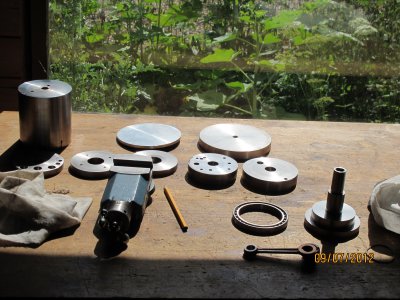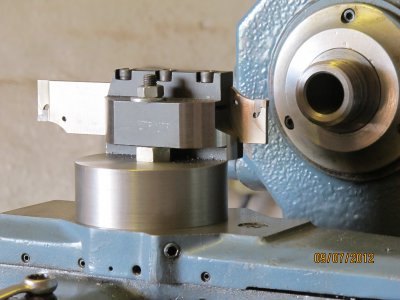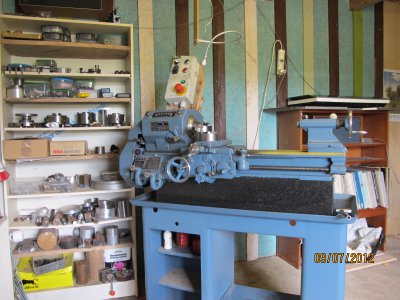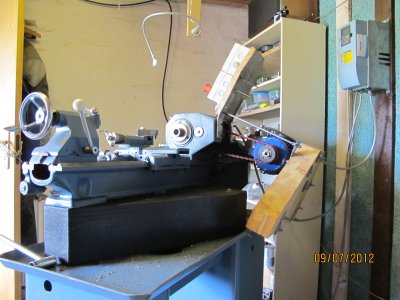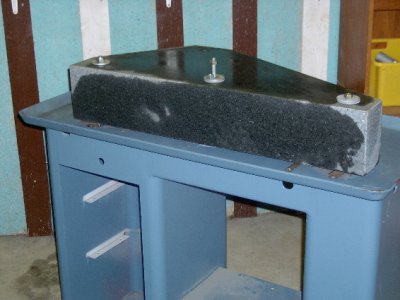- Joined
- Jul 1, 2012
- Messages
- 1,356
Hello Everyone.
I have been thinking about future topics we should discuss on this thread:
- Leveling and Aligning machine tools
- What's, Why's and How Come we Hand-scrape and 1/2 Moon Oil Flake
- When a machine needs to be rebuilt
- Can You Rebuild your own machine?
- How do I pick a rebuilding company?
- How to adjust a Gib
- Where and how to install wear-strips and shims on machines
- Oil Lubrication
- Preventive Maintenance
- The use Kinematics or 3 - Points suspension in machine tools
I hope you can suggest some topics too.
I have been a Machine Tool Rebuilder for 40+ years apprenticing under my Dad. I was very fortunate during my apprenticeship. My Dad, who was a Journeyman Machinist and Machine Rebulder, worked at a used machine dealer in Minneapolis where we rebuilt dozens of different types and brands of machine tools. I saw so many problems and issues like worn ways, replaced bearings, rebuilt hydraulic pumps, built hydraulic systems. I got a great education.
Over the years my Dad specialized in scraping precision machine tools and surface plates where I learned how to scrape very very accurately. Before granite became popular as surface plates, machinists and rebuilders relied upon scraping 3 exact sized cast iron plates to generate precision flat surface plates. We would lap them together and then scrape them using Prussian Blue and then they were scraped to precision classes. In machine tools we consider .0002" per 12", precision and .00005" per 12" for Super Precision.
Bearing points are generated using hand scrapers. A Bearing spot or point is a high spot left when we rub the plates together using Prussian blue on one plate and where it rubs off on the other plates, we scrape it off and the more you scrape it the flatter it gets and as you scrape shorter and shorter scrape marks you get what we call is "points per inch". Conventional machine are scraped 12 to 18 points on average and 38 to 42 on Super Precision.
As a rule of thumb machines like a South Bend Lathe, Bridgeport Mill, KO Lee Surface Grinder, Cleveland Planers, etc. are considered "Conventional" style machines and are considered "Precision". Machines like Studer Cylindrical Grinders, Moore Jig Bores, Cincinnati Mon-o-set Tool and Cutter Grinders, Brown and Shape Surface Grinders, cast iron plates, cast iron straight-edges, etc. are Super Precision.
More on scraping next time.
I will do my best to answer any questions you have about machine repair and machine rebuilding. I will try to look at the web-site 2 to 3 times daily and more when I am not rebuilding machinery. At the moment I am scheduled to rescrape the ways on a Okuma Howa Vertical Machining Center, the Ways, alignment of the head-stock and tail-stock on a Drake Thread Grinder and I will be teaching a scraping seminar here in Minnesota.
I am always looking for hosts to hold scraping classes. I will be teaching the next class inside the garage shop of a friend and former student. All we need is a surface plate and work benches and some assorted tools that most of you have.
I also teach seminars inside plants and shops all around the world. I have been teaching seminars for several years now and have taught over 15,000 men and women to scrape in companies like GM, Timken, Cummins, John Deere, etc. here in the USA and have taught at several new machine builders in Taiwan. I will gather together some pictures and add them soon.
Thanks for asking me to your Moderator.
More later. Please ask away.
Richard
I have been thinking about future topics we should discuss on this thread:
- Leveling and Aligning machine tools
- What's, Why's and How Come we Hand-scrape and 1/2 Moon Oil Flake
- When a machine needs to be rebuilt
- Can You Rebuild your own machine?
- How do I pick a rebuilding company?
- How to adjust a Gib
- Where and how to install wear-strips and shims on machines
- Oil Lubrication
- Preventive Maintenance
- The use Kinematics or 3 - Points suspension in machine tools
I hope you can suggest some topics too.
I have been a Machine Tool Rebuilder for 40+ years apprenticing under my Dad. I was very fortunate during my apprenticeship. My Dad, who was a Journeyman Machinist and Machine Rebulder, worked at a used machine dealer in Minneapolis where we rebuilt dozens of different types and brands of machine tools. I saw so many problems and issues like worn ways, replaced bearings, rebuilt hydraulic pumps, built hydraulic systems. I got a great education.
Over the years my Dad specialized in scraping precision machine tools and surface plates where I learned how to scrape very very accurately. Before granite became popular as surface plates, machinists and rebuilders relied upon scraping 3 exact sized cast iron plates to generate precision flat surface plates. We would lap them together and then scrape them using Prussian Blue and then they were scraped to precision classes. In machine tools we consider .0002" per 12", precision and .00005" per 12" for Super Precision.
Bearing points are generated using hand scrapers. A Bearing spot or point is a high spot left when we rub the plates together using Prussian blue on one plate and where it rubs off on the other plates, we scrape it off and the more you scrape it the flatter it gets and as you scrape shorter and shorter scrape marks you get what we call is "points per inch". Conventional machine are scraped 12 to 18 points on average and 38 to 42 on Super Precision.
As a rule of thumb machines like a South Bend Lathe, Bridgeport Mill, KO Lee Surface Grinder, Cleveland Planers, etc. are considered "Conventional" style machines and are considered "Precision". Machines like Studer Cylindrical Grinders, Moore Jig Bores, Cincinnati Mon-o-set Tool and Cutter Grinders, Brown and Shape Surface Grinders, cast iron plates, cast iron straight-edges, etc. are Super Precision.
More on scraping next time.
I will do my best to answer any questions you have about machine repair and machine rebuilding. I will try to look at the web-site 2 to 3 times daily and more when I am not rebuilding machinery. At the moment I am scheduled to rescrape the ways on a Okuma Howa Vertical Machining Center, the Ways, alignment of the head-stock and tail-stock on a Drake Thread Grinder and I will be teaching a scraping seminar here in Minnesota.
I am always looking for hosts to hold scraping classes. I will be teaching the next class inside the garage shop of a friend and former student. All we need is a surface plate and work benches and some assorted tools that most of you have.
I also teach seminars inside plants and shops all around the world. I have been teaching seminars for several years now and have taught over 15,000 men and women to scrape in companies like GM, Timken, Cummins, John Deere, etc. here in the USA and have taught at several new machine builders in Taiwan. I will gather together some pictures and add them soon.
Thanks for asking me to your Moderator.
More later. Please ask away.
Richard
Last edited by a moderator:

